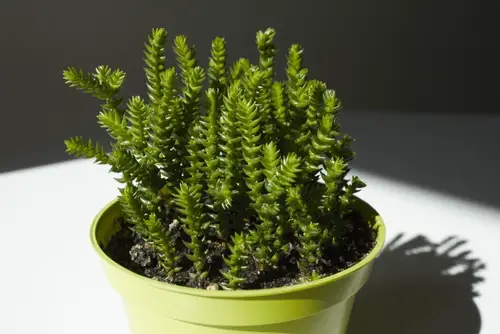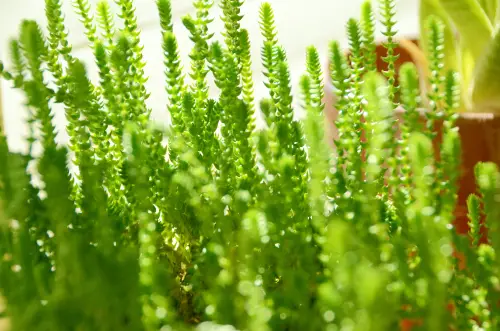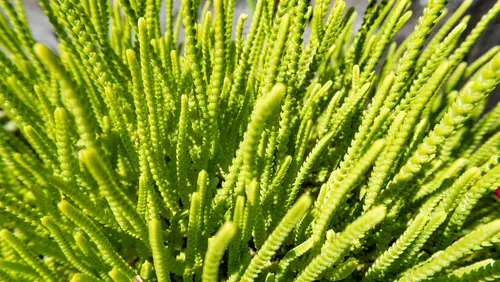Watch Chain plants are a popular choice for succulent enthusiasts due to their unique appearance and low maintenance requirements. However, one common problem that many plant owners face is the watch chain plant turning brown. This can be a frustrating issue, but with the right knowledge, it can be easily remedied.
Identifying the cause of browning in a Watch Chain plant is the first step in finding a solution. There are several potential causes, including environmental stressors, improper care, pests, and diseases.
Environmental stressors such as excessive heat, cold, or wind can cause the leaves to turn brown and eventually die. Improper care, such as overwatering or underwatering, can also lead to browning.
Pests and diseases can also be a culprit, so it’s important to thoroughly inspect the plant for any signs of infestation or infection.
Understanding the specific problem with a Watch Chain plant is crucial in determining the appropriate solution. By identifying the cause of browning, plant owners can take the necessary steps to correct the issue and prevent it from happening again in the future.
With proper care and attention, Watch Chain plants can thrive and continue to add beauty to any succulent collection.
Key Takeaways
- Identifying the cause of browning in a Watch Chain plant is the first step in finding a solution.
- Environmental stressors, improper care, pests, and diseases can all contribute to browning in a Watch Chain plant.
- By understanding the problem and taking the appropriate steps, Watch Chain plants can continue to thrive and add beauty to any succulent collection.
More on this category:
- Why Is My Umbrella Plant Turning Brown?
- Why Is My Tradescantia Turning Brown?
- Why Is My Tradescantia Nanouk Turning Brown?
Identifying a Watch Chain Plant

Watch Chain plants, also known as Crassula muscosa, are a popular succulent that is easy to care for and adds a unique touch to any indoor or outdoor garden. The plant gets its name from its long, thin stems that resemble a chain, with small, triangular leaves growing in clusters along the stem.
The plant is also commonly known as the zipper plant, rattail crassula, and crassula lycopodioides. It is a member of the Crassulaceae family and is native to South Africa.
Watch Chain plants are usually small, growing up to 6 inches in height, and are often used in rock gardens, terrariums, and as ground cover. They are low maintenance and can grow in a variety of conditions, making them a popular choice for beginners and experienced gardeners alike.
One of the most distinctive features of the Watch Chain plant is its unique growth pattern. The plant grows in a cascading manner, with the stems hanging down and the leaves pointing upwards. The leaves are small and triangular, with a glossy green color that can turn reddish-brown in full sun.
If you are unsure whether you have a Watch Chain plant or not, look for the characteristic chain-like stems and triangular leaves growing in clusters along the stem. If you are still unsure, you can take a picture of the plant and compare it to pictures online or consult a gardening expert.
Understanding the Problem
Watch Chain plants are beautiful succulents that are known for their striking appearance and unique texture. However, sometimes these plants can experience problems that can cause them to turn brown and eventually die. In this section, we will explore the reasons behind this issue and how to prevent it.
One of the most common reasons for a Watch Chain plant to turn brown is environmental stressors such as excessive heat, cold, or wind. If the plant is exposed to any of these elements for extended periods of time, it can cause the leaves to turn brown and eventually die.
Therefore, it is essential to ensure that the Watch Chain plant is placed in an area where it can receive adequate sunlight and protection from harsh weather conditions.
Overwatering is another common reason for brown spots on the Watch Chain plant. This plant prefers well-draining soil and does not like to sit in water.
When the plant is overwatered, the roots can become waterlogged, leading to root rot, which can cause the leaves to turn yellow and eventually brown. Therefore, it is important to water the plant only when the soil is dry to the touch.
Another reason why the Watch Chain plant may turn brown is due to pests and diseases. Spider mites and mealybugs are common pests that can cause damage to the plant, leading to browning of the leaves.
Additionally, fungal infections can also cause browning of the leaves. Therefore, it is essential to inspect the plant regularly for any signs of pests or diseases and take appropriate measures to control them.
Why Is My Watch Chain Plant Turning Brown – 4 Common Problems

Watch Chain plants are known for their attractive foliage and unique texture, but sometimes they can start to turn brown. This can be a sign of a problem with the plant’s health, and it’s important to identify the cause of the issue in order to take the appropriate steps to correct it.
Here are some of the common causes of browning in Watch Chain plants:
1. Overwatering and Root Rot
One of the most common causes of browning in Watch Chain plants is overwatering. When the soil is consistently too wet, it can lead to root rot, which can cause the leaves to turn brown and eventually fall off. To prevent overwatering, it’s important to make sure the soil is well-draining and that the plant is not sitting in standing water.
2. Pests
Pests like mealybugs and spider mites can also cause browning in Watch Chain plants. These insects feed on the plant’s sap, which can cause the leaves to turn brown and eventually die. To prevent and treat pest infestations, it’s important to regularly inspect the plant for signs of insects and to use appropriate insecticides as needed.
3. Fungal Diseases
Fungal diseases like powdery mildew can also cause browning in Watch Chain plants. These diseases can be caused by a variety of factors, including high humidity, poor air circulation, and overwatering.
To prevent and treat fungal diseases, it’s important to keep the plant’s environment clean and dry, and to use appropriate fungicides as needed.
4. Nutrient Deficiency
A lack of nutrients can also cause browning in Watch Chain plants. If the plant is not getting enough of the essential nutrients it needs, the leaves may start to turn brown and eventually fall off. To prevent nutrient deficiencies, it’s important to use a balanced fertilizer and to make sure the plant is getting enough sunlight and water.
By identifying the cause of browning in Watch Chain plants, it’s possible to take the appropriate steps to correct the issue and keep the plant healthy and thriving.
Role of Environmental Factors

Environmental factors play a significant role in the health of a Watch Chain plant. One of the most common reasons for a Watch Chain plant to turn brown is environmental stressors such as excessive heat, cold, or wind.
If the plant is exposed to any of these elements for extended periods, it can cause the leaves to turn brown and eventually die.
Another environmental factor that can cause brown spots on the Watch Chain plant is low humidity levels. The plant thrives in a humid environment and can suffer from brown spots if the air is too dry. In low humidity conditions, the plant will struggle to absorb moisture through its leaves and may develop brown patches.
Watering is another crucial environmental factor that can affect the health of the Watch Chain plant. Overwatering can lead to root rot, which can cause the leaves to turn brown and eventually fall off.
On the other hand, underwatering can also cause the leaves to turn brown and dry out. It is essential to strike a balance between the two and ensure that the plant is watered appropriately.
The type of soil and sunlight exposure can also impact the health of the Watch Chain plant. It is best to plant the Watch Chain in well-drained soil in full sun to light shade. If planting indoors, place it in a room that gets a lot of sunlight.
The best color is maintained with a bit of shade even on the coast. Watch Chain has typical watering needs for a succulent. It is best to use the “soak and dry” method, allowing the soil to dry out completely.
Finally, air circulation is essential for the health of the Watch Chain plant. Poor air circulation can lead to fungal diseases, which can cause the leaves to turn brown and eventually fall off. It is vital to ensure that the plant is placed in an area with adequate air circulation to prevent such diseases.
Proper Care for Watch Chain Plants
Watch Chain plants are easy to care for and can be grown indoors or outdoors. Proper care will help prevent your plant from turning brown or suffering from other issues. Here are some tips for caring for your Watch Chain plant:
1. Watering
Watch Chain plants prefer well-draining soil and should be watered moderately. Overwatering can lead to root rot, which can cause the leaves to turn brown.
A good rule of thumb is to water your plant once a week during the growing season and reduce the frequency during winter when growth slows down. It’s also important to let the soil dry out between waterings.
2. Sunlight

Watch Chain plants prefer bright, indirect sunlight. They can tolerate some morning sun, even in the hottest part of summer, but it’s best to combine it with some type of shade. If your plant is exposed to too much direct sunlight, the leaves can turn brown and eventually die.
3. Soil
Watch Chain plants prefer well-draining soil that is rich in organic matter. You can use a cactus or succulent mix or make your own by combining sand, perlite, and peat moss. It’s important to repot your plant every two to three years to ensure it has enough room to grow.
4. Fertilizing
Watch Chain plants don’t require a lot of fertilizer, but a controlled-release fertilizer can help promote healthy growth. It’s best to fertilize your plant during the growing season and avoid fertilizing during the winter months.
5. Propagation
Watch Chain plants can be propagated from stem cuttings. Simply cut a stem from the plant and allow it to dry out for a few days. Once the stem has calloused over, plant it in well-draining soil and water sparingly. The stem should take root within a few weeks.
6. Other Tips
- Watch Chain plants prefer a humid environment and can suffer from brown spots if the air is too dry. You can mist your plant or place a humidifier nearby to increase humidity.
- Watch Chain plants can be used in succulent arrangements or planted in a pot on their own.
- Watch Chain plants are also known as Princess Pine, Clubmoss Crassula, Mossy Crassula, and Lycopodium Crassula.
- Watch Chain plants can grow up to 6 inches tall and 12 inches wide, making them a great thriller plant in a container garden.
- Watch Chain plants have small, white flowers that bloom in the summer.
By following these instructions for proper care, you can keep your Watch Chain plant healthy and prevent it from turning brown.
Propagation of Watch Chain Plants
Watch Chain plants are easy to propagate and make great additions to any succulent collection. Propagation can be done through stem cuttings, leaf cuttings, or by dividing the plant.
To propagate a Watch Chain plant through stem cuttings, make a clean cut with a sharp knife or pair of scissors just below a leaf node. Allow the cutting to dry for a few days before planting it in well-draining soil.
Keep the soil moist but not too wet, and place the cutting in a bright, indirect light. After a few weeks, the cutting should start to grow roots and new leaves.
Leaf cuttings can also be used to propagate Watch Chain plants. To take a leaf cutting, gently twist a leaf from the stem, making sure to include a small piece of the stem.
Allow the cutting to dry for a few days before planting it in well-draining soil. Keep the soil moist but not too wet, and place the cutting in a bright, indirect light. After a few weeks, the cutting should start to grow roots and new leaves.
Dividing a mature Watch Chain plant is another way to propagate it. Carefully remove the plant from its pot and gently separate the roots. Plant each section in its own pot with well-draining soil, and water thoroughly. Place the newly divided plants in a bright, indirect light.
Propagation of Watch Chain plants is best done in the spring or summer when the plant is actively growing. With proper care and attention, Watch Chain plants can be easily propagated and enjoyed for years to come.
Dealing with Pests and Diseases

Pests and diseases can cause brown spots and discoloration on the leaves of the Watch Chain plant. Common pests that can affect the Watch Chain plant include spider mites and mealybugs. These insects feed on the sap of the plant and can cause damage to the leaves.
To prevent pests, it is important to inspect the plant regularly and remove any visible bugs with a damp cloth or cotton swab. Insecticidal soap can also be used to control pests.
Powdery mildew is a common fungal disease that can affect the Watch Chain plant. This disease causes a white, powdery coating on the leaves and can cause them to turn yellow and fall off.
To prevent powdery mildew, it is important to avoid overwatering the plant and to ensure that there is good air circulation around it. If powdery mildew is present, a fungicide can be used to control the disease.
Black spots on the leaves of the Watch Chain plant can be a sign of a fungal disease. This disease can cause the leaves to turn yellow and fall off. To prevent fungal diseases, it is important to avoid overwatering the plant and to ensure that it is not in a damp or humid environment. A fungicide can be used to control fungal diseases.
Conclusion
There are several reasons why a Watch Chain plant may turn brown, including environmental stressors, over or under-watering, nutrient deficiency, lack of humidity, and pests. It is important to identify the underlying issue and take appropriate action to ensure the plant’s health.
Environmental stressors, such as excessive heat, cold, or wind, can cause the leaves of the Watch Chain plant to turn brown and eventually die. It is important to ensure that the plant is not exposed to any of these elements for extended periods of time.
Over or under-watering can also cause the plant to turn brown. It is important to ensure that the soil is moist but not waterlogged and that the plant is not left in standing water.
Nutrient deficiency can also cause brown spots on the leaves of the plant. It is important to fertilize the plant regularly and ensure that it is receiving the necessary nutrients.
Lack of humidity can also cause the Watch Chain plant to turn brown. The plant requires a humid environment to thrive, and it is important to mist the plant regularly or use a humidifier to maintain the necessary humidity levels.
Pests can also cause brown spots on the leaves of the Watch Chain plant. It is important to inspect the plant regularly for signs of pests and take appropriate action to eliminate them.
Overall, the Watch Chain plant is an easy-to-care-for houseplant that is native to South Africa. It is cold hardy and can bloom with proper care.
However, it is important to ensure that the plant is not toxic or invasive and that it is planted in well-draining soil with perlite or pumice. With proper care, the Watch Chain plant can be a beautiful spiller in any indoor or outdoor garden.
Finally, if you have any further questions about the Watch Chain plant, you can check out the FAQ section on various gardening websites or contact your local gardening store for more information.
Frequently Asked Questions

How much light does a watch chain plant need?
Watch chain plants prefer bright, indirect light. They can tolerate some direct sunlight, but too much can cause the leaves to burn. If the plant is not getting enough light, it may become leggy and the leaves may turn pale green or yellow.
What is the ideal watering schedule for a watch chain plant?
Watch chain plants are succulents and can store water in their leaves. They prefer to be watered thoroughly but infrequently. The soil should be allowed to dry out completely between waterings. Overwatering can cause the roots to rot and the leaves to turn brown.
What are some common causes of browning in succulents?
Environmental stressors such as excessive heat, cold, or wind can cause succulent leaves to turn brown. Overwatering, underwatering, and poor soil drainage can also cause the roots to rot and the leaves to turn brown.
How can I tell if my watch chain plant is being overwatered?
If the leaves of a watch chain plant are turning brown and mushy, it may be a sign of overwatering. The soil should be allowed to dry out completely between waterings. If the plant is in a container without drainage holes, it may be retaining too much water.
Can a watch chain plant recover from browning?
If the browning is due to environmental stressors or overwatering, the plant may be able to recover if the underlying issue is addressed. However, if the browning is due to root rot, the plant may not be able to recover and may need to be discarded.
What are some tips for propagating a watch chain plant successfully?
Watch chain plants can be propagated from stem cuttings. The cutting should be allowed to dry out for a few days before being planted in well-draining soil. The soil should be kept moist but not wet until the cutting has rooted. Propagation is best done during the warm season.

Hey, I’m Lisa and I’ve been an avid gardener for over 30 years. I love writing, talking and living in the garden! Feel free to connect with me on my socials below

